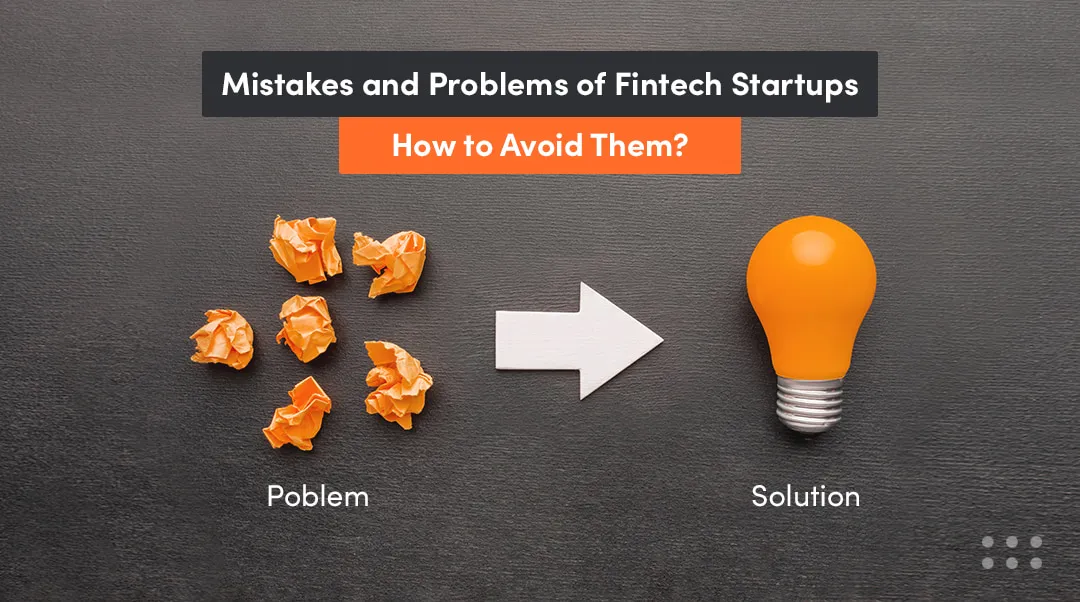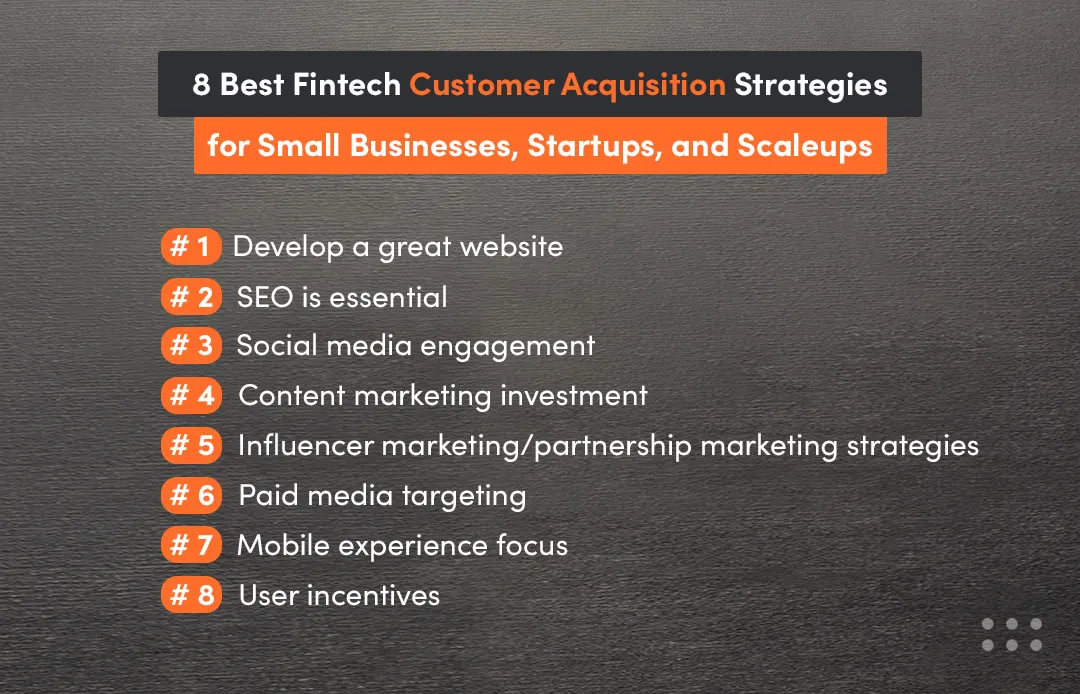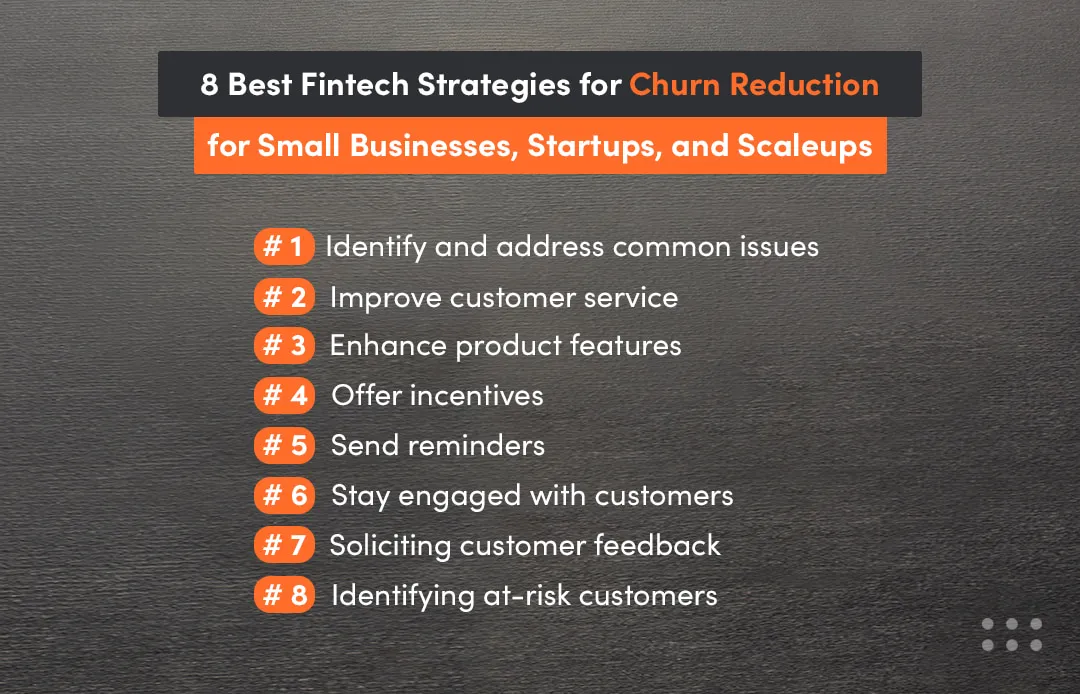About 90% of startups fail – As stated in the Business Employment Dynamics report from the Bureau of Labor. Out of all interviewed founders, only 16% pointed to financial problems as the main reason for their failure. So, what are the other reasons for failure?
The primary goal of any fintech startup is business growth to meet the operational expenses. To achieve this goal, startups must decrease customer turnover while increasing new customer acquisition. A fintech startup won't last if it doesn't have customers.
Customer churn reduction is critical for startups because it assures customer loyalty and satisfaction, which leads to a greater lifetime customer value (LTV). It also helps fintech companies to save money.
Fortunately, some fintech marketing strategies can help startups increase customer acquisition and reduce churn rate. In this article, you will get to know all about the best strategies a startup can implement to scale up their business.
What will you learn from this section?
- Goals and challenges faced by fintech startups in marketing,
- Mistakes and problems of fintech startups and how to avoid them,
- What is Agile methodology and how does it matter in fintech?
- Best strategies for customer acquisition and customer retention,
- Role of gamification in financial industry and how can it help fintech startups,
- The newest trend in fintech and how to adopt them.
What are the Goals and Challenges of Fintech Marketing?
A fintech app marketer must know the best marketing tools to create the best strategies.
The most effective fintech marketing strategies use video marketing, referral marketing, collaboration marketing, and social media to drive traffic, improve customer loyalty, and expand business opportunities.
Challenges of Fintech Marketing Strategies
- The biggest challenge for a startup is building and maintaining customer trust. Customers are growing more concerned about their personal and financial data security due to increased data breaches. Fintech companies need to spend money on the newest financial technology to protect consumer data, be open and honest about their data security policy, and inform customers on how to keep their information secure.
- Staying ahead in a highly competitive market is another big challenge. Newly launched fintech firms must innovate and offer consumers distinctive and appealing value offerings. It can be done by utilizing cutting-edge technologies like blockchain, AI, machine learning, and machine translation to provide seamless user experiences and personalized user journeys.
- Keeping up with rapidly evolving digital trends and technologies is the demand of fintech marketing strategies. Fintech companies must stay up to date on the newest trends and technology. It requires employing data-driven insights to guide marketing tactics, utilizing social media and other digital platforms to connect with the target market, and investing in mobile-first experiences to satisfy the rising demand for mobile banking and financial management solutions.
Why Does Agile Methodology Matter in Fintech?
With the fintech business rising from USD 5.2 billion in 2020 to USD 37.3 billion in 2022, one thing is obvious: if you want a piece of the pie, you must bring the product to market as quickly as possible. Speed and agility can only be achieved with Agile Methodology. Here are some of the reasons why?
Adapting to change
Fintech companies must implement legitimate technologies faster than before while maintaining quality and security. Agile provides a critical answer because of its quick timetable and flexibility to interface with existing systems.
Resolving challenges
Every fintech company has problems, and it begins when staff are required to follow rigid instructions rather than a more natural approach to tackle a problem. Agile provides a continual problem-solving capability that enables FinTech startups to adapt to current difficulties rather than follow the previous ones.
Testing new strategies
Usually, a new startup would have to spend much time and money testing a hypothesis. It can be done easily with Agile, often for less money and time. Agile can swiftly assess how effectively processes will function by deploying, observing, and modifying them. For example, if you wish to investigate the benefits of an AI-based risk management tool, it may be swiftly created, tested, deployed, and evaluated for efficacy.
Meeting the demands of customers
Customers today want service at their fingertips, convenience of use, and faster decision-making than before. Agile methodology enables fintech startups to achieve feasibility and convenience as the new strategies can be swiftly implemented or scaled down to meet market demand.
Having common goals
Fintech teams prefer to operate in silos, each focused solely on their particular component. While agile encourages splitting work into iterations, it succeeds in one area where traditional marketing tactics fail: keeping the team focused on a single goal. So, the overarching aim is apparent to everyone, and each member has a part in making that goal a reality. The paradigm of cross-functional collaboration is the beauty of Agile methodology.
Try our developers.
Free for 2 weeks.
No risk. Just results. Get a feel for our process, speed, and quality — work with our developers for a trial sprint and see why global companies choose Selleo.
Mistakes and Problems of Fintech Startups - How to Avoid Them?

Here are some mistakes fintech startups make that lead them to failure. These problems and mistakes can be avoided, and here's how:
Failing to Build Trust with Users
Today's Fintech consumer desires reassurance that their money is secure before agreeing to move to a financial app.
According to research, just 45% of UK consumers trusted internet banks as much as conventional banks.
Customers want to know the sophisticated security mechanisms fintech apps use to protect their personal and financial data. Users do not trust an app that exhibits robotic behavior or has difficulty offering assistance.
Solution
Put your efforts towards establishing a unified brand voice across the UX design. This applies to the graphics, text, tone, and other elements used in websites, applications, and other fintech marketing materials.
For instance, Klarna explains its assortment of financial services using straightforward language and a constant tone of voice.
Good UX components that foster trust include clear instructions, simple-to-follow actions, quick access to assistance, and social media existence.
Treating Security as an Afterthought
Neglecting security is a mistake that has led to the collapse of several fintech startups.
Revolut has had a security vulnerability in a targeted attack that revealed the personal data of over 50,000 users worldwide.
Global governments are aware of the rising cyber risks and have implemented legislation and regulations that fintech companies must follow.
A lack of understanding of cloud security can worsen data vulnerability. Many startups believe that cloud security is primarily the responsibility of the service providers. This is an incorrect assumption because cloud providers are only accountable for a subset of the infrastructure. Startups must be responsible for securing their apps, databases, middleware, and APIs.
Solution
Make security a priority in the development of fintech apps. Fintech startups must safeguard money and consumer information by implementing secure financial technology such as:
- encryption,
- multi-factor authentication,
- identity verification.
When designing the app, developers must evaluate the security risk of the technology stacks involved, including cloud servers, APIs, databases, and other third-party interfaces.
In addition to security measures, fintech companies must abide by the necessary laws, such as GDPR and PSD2 SCA in Europe and AML, GLBA, and the JOBS Act in the US. Compliance with these rules prevents startups from facing penalties and safeguards clients' data.
Delivering a Poor User Experience
According to one survey, 88% of users would abandon an app if it was riddled with problems. Expecting users to navigate through difficulties or experience app failures regularly is unreasonable.
Aside from a broken app, complex onboarding, and in-app app activities are major contributors to a high churn rate. According to another survey, 80% of users removed an app because they couldn't figure out how to utilize it. This is critical for fintech startups because the clients are concerned about their money and have minimal error tolerance.
Solution
Before releasing it to the public, thoroughly test the fintech application for bugs and other technical difficulties. Working with programmers who have a track record of creating apps that are free of bugs is necessary to achieve this.
Adding Superficial Features While Neglecting Fundamental Ones
More features do not ensure a higher retention rate. Instead, if you provide advancements that do not lead to a better user experience, the reverse is more likely to occur.
For example, 37 Coins offered Bitcoin transfer services through SMS. Despite its adaptability, the Fintech company eventually shut down two years later because it couldn't successfully send Bitcoin outside the US.
Solution
When developing fintech apps, focus on what the target audience wants rather than on unproven assumptions. Employ surveys and interviews to uncover users' expectations from the Fintech app.
Using an unprofitable business model
Business models give strategic control on distinctive aspects and tactical income generation methods. Some fintech startups fail due to a lack of a sustainable business plan.
Xinja, a financial startup aimed at the Australian market, shut down in 2020 due to a poor business plan that provided the highest interest rate on deposits. The fintech company failed to profit because it accepted too many deposits and provided too few loans.
Solution
Determine which business model is appropriate for the fintech app and will be lucrative in the long run. Before building the app, undertake a product discovery. This enables you to select or combine feasible company models that are best for the FinTech startup.
8 Best Fintech Customer Acquisition Strategies for Small Businesses, Startups, and Scaleups
Digital marketing is the best way for fintech companies to attract new product and service customers. Fintech's marketing strategy includes creating valuable content for social media marketing, paid campaigns, seasonal marketing campaigns, traditional marketing channels, and collaboration marketing.

Here are the eight best fintech marketing strategies for startups:
Fintech Marketing Tactic # 1 - Develop a Great Website
Building a user-friendly, appealing website will allow customers to discover everything there is to know about the company, product, and services. It is the first and basic step of any fintech marketing strategy.
Make sure to accurately and enthusiastically describe the product, highlight its benefits, and provide customers with the most current contact information and links to social media profiles so they know you are accessible to discuss their requirements and respond to any inquiries.
Example: Atom Bank places calls to action for installing their app in the main section of their webpage. This is a wonderful site, and they truly stand out.
Fintech Marketing Tactic # 2 - SEO Is Essential
Search Engine Optimization is one of the most impactful aspects of a successful Fintech marketing strategy. SEO is all about choosing the right keywords to help potential customers find the company website or blog when searching it on Google, Yahoo, DuckDuck Go, or any other search engine.
If a startup selects a list of single-word keywords, it will take them months and even years to rank, as single keywords are highly competitive.
Instead, startups should consider using long-tail keywords for their blogs and landing pages at the initial stage. Creating backlinks, getting mentions on authority-relevant websites, and community marketing will help startups rank high on search engines for respective keywords.
Fintech Marketing Tactic # 3 - Social Media Engagement
Social media marketing is one of the best ways to attract new FinTech clients. Buyers can be approached at any point in the marketing funnel.
For brand research, more than 75% of people utilize social media. Startups can also incorporate content for social media marketing that encourages interaction and seeks conversions.
Create social media campaigns as part of fintech marketing strategies to:
- Reach new audiences,
- Build trust via community marketing,
- Personalize your brand,
- Strengthen relationships,
- Provide customer service,
- Perform industry/customer research.
The fintech sector's most notable social media platforms are Facebook, Twitter, LinkedIn, Instagram, YouTube, Reddit, and Medium.
Fintech Marketing Tactic # 4 - Content Marketing Investment
Content marketing helps startups attract new customers by offering educational and informational material for their search queries. It also helps gain trust and build a reputation among existing clients by offering relevant materials such as "How-to-Guides" and "Best Tips" blogs.
The most notable channels for content marketing are video marketing, white papers, case studies, eBooks, infographics, podcasts, webinars, and brochures.
Fintech industry bloggers can also optimize content marketing efforts to create valuable content to educate customers.
Fintech Marketing Tactic # 5 - Influencer Marketing/Partnership Marketing Strategies
The biggest target audience of financial technology is Gen Z. Influencer marketing strategies allow startups access to this demographic.
Fintech's marketing strategies will involve finding the right influencer for the brand who advertises your product or service among their followers via video content, shoutouts, or story content.
When an influencer advertises Fintech items on TikTok, Instagram, or YouTube, people are more than likely to purchase them. These partnership marketing tactics can help startups to increase the number of paying customers.
Fintech Marketing Tactic # 6 - Paid Media Targeting
Unlike billboards, television adverts, and radio advertisements, ad campaigns interact with users at the appropriate time and place when they have already started looking for a solution online.
Fintech marketing campaigns for paid platforms such as Google, YouTube, Facebook, LinkedIn, and Twitter depend heavily on the right strategies.
Fintech products designed for the masses should be advertised on Google, Facebook, and YouTube. Although YouTube is a highly expensive medium and may not produce the ROI. Similarly, Corporate level products should be advertised on Google and LinkedIn.
A well-researched fintech marketing strategy for paid advertisement should consider answering these questions in detail before investing heavily. If the strategy fails, the fintech companies will lose invested money.
- What will be the budget?
- Who will be the target audience?
- Where does the target audience spend most of their time?
- What are the best advertising platforms?
- What will be the ad copy?
Once your advertising campaign has begun, monitor analytics, evaluate the outcomes, and make any necessary adjustments.
Fintech Marketing Tactic # 7 - Mobile Experience Focus
Focusing on mobile improves the user experience, speed, and simplicity of use.
Potential customers will abandon the app or website on mobile devices if they face difficulties.
Prioritize Fintech user's mobile experience by:
- Having a mobile-responsive website (and ads),
- Using a straightforward and simplistic interface,
- Incorporating seamless navigation,
- Writing concise and straightforward copy,
- Eliminating pop-ups,
- Speeding up load times,
- Conducting regular analysis.
Make it easy for potential Fintech customers to understand the message. Remove barriers to content and create a user-friendly experience.
Fintech Marketing Tactic # 8 - User Incentives
Incentives are an important part of a Fintech marketing strategy.
Customers who take action to receive incentives are more likely to purchase the goods and services.
They're also more inclined to tell their friends and family about the company. Games like tournaments, quizzes, and riddles make incentivizing dedicated users even more appealing.
Reward new and existing customers with freebies like:
- Cashback
- Signup bonuses
- Referral bonuses
- Cash rewards for milestones
- Discounts on other brands
- Choice of rewards
- Free services
With incentives, you'll stand out among the crowd if your competitors don't offer freebies.
8 Best Fintech Strategies for Churn Reduction for Small Businesses, Startups, and Scaleups

Here are the eight best elements of a fintech marketing strategy that startups can implement in their business plan to reduce customer churn:
Identify and Address Common Issues: Startups can identify prevalent difficulties driving clients to cancel their memberships or services by using surveys or feedback forms. Once the problem has been discovered, take action to remedy it and prevent it from recurring.
Improve Customer Service: Maintaining customer satisfaction and lowering turnover need excellent customer service. Make sure that the workforce is well-trained and capable of responding to client questions in a timely way. Consider providing clients with numerous channels for contacting customer support, such as live chat, email, and phone.
Enhance Product Features: Customers may move to another supplier if dissatisfied with the product or service's features. You should frequently examine user input and make appropriate product or service modifications to engage customers and prevent churn.
Offer Incentives: Providing incentives can be an effective approach to keep customers loyal. Consider creating loyalty programs where customers can win prizes for using the app regularly.
Send Reminders: When renewing their membership, customers who have forgotten about goods or services are inclined not to do so. Send customers reminders before their membership expires to ensure they know about the product or service.
Stay Engaged with Customers: Maintaining customers' interest is essential for lowering churn rates. Make sure to notify customers of new features or deals they might be interested in through frequent communication.
Soliciting customer feedback: Listening to clients in the early phases is very important. Look for ways to get in touch with customers and learn what they like and dislike about the products and services, what they are most worried about, what features are lacking from the platform, etc. Then, reply to them and find solutions.
Identifying at-risk customers: It is not difficult to identify at-risk clients. Startups should investigate and try to comprehend what motivates people to leave the company in the first place. If a business is careful enough, it may be able to view things from the client's perspective.
As this is the era of AI, many startups integrate AI tools to evaluate, identify, monitor, and reduce churn rates. There are many tools available to do the job. Lacale.ai is one example of helping a leading fintech SaaS platform decrease user churn by 15% and attain operational efficiency.
The AI tool helps the business to set proactive alerts on the most pressing issue as and when it arises. It reduces the chances of discovering the problems days later as it happened. It helps to improve the ownership of the fintech marketing team by adding auto-resolved features in their system.
The strategy helped the business reduce 15% of customer churn in just a few months.
Is It Possible to Build a Retention Strategy in Fintech?
Retention is a part of a successful Fintech marketing strategy. Enhancing customer loyalty, extending the customer lifetime value, and lowering customer acquisition expenses are all impacted by higher retention rates.
Building a retention strategy for a Fintech-based product and service is certainly possible. Fintech products, such as digital banking, investment, insurance, and blockchain apps, are mainly used for a longer period.
Because of this, Fintech startups are constantly looking for new methods to increase customer engagement, satisfaction, and loyalty.
One of the elements of a best customer retention strategy is utilizing data analytics. Fintech startups can analyze customers' behavior patterns and transactions to get valuable insight into their preferences and pain points. With that knowledge, startups can design customized solutions, enhance design usability, and preempt issues before they arise.
Innovation is another important aspect of a successful fintech marketing strategy. New innovative fintech brands keep the customers engaged and excited about what's next. It can be a new investment opportunity or an innovative payment solution - the new Fintech brands add more value for customers who regularly use them.
The last but most important prospect of a retention strategy is personalized and empathetic customer support. 24/7 live chat or ticket support is one of the norms of the financial technology industry. Improving the overall quality of the service can help you reap the fruits of all your marketing efforts.
Gamification in Financial Software? - How Can It Bring More Customers?

According to MarketsandMarkets, the gamification market size is estimated to grow from $9.1 billion in 2020 to $30.7 billion by 2025.
Gamification is the newest trend in the fintech industry. It is a key psychological concept that gamification is based on operant conditioning, which means that behavior can be shaped and modified by the consequences that follow it. For example, if an app offers a reward to its consumer for completing a task, the consumer will try to earn as many rewards as possible, increasing the time used for the app. It is also possible that the consumer will tell their family and friends about the app and the reward system, which will attract more consumers.
Trends to Enhance Your App User Acquisition
Fintech marketing is already being impacted heavily by AI and Blockchain. These are the newest. These are trends for traditional financial institutions that have not prepared their teams to adapt to these trends. Here are some of the newest trends in Fintech for 2023 and how a startup can prepare for these trends.
Collaboration: By collaborating with other businesses, a fintech startup can grow its customer base and offer value to its products and services.
Promotions and Discounts: By giving promotions, discounts, and referral programs, financial companies can entice new consumers to join up and existing customers to continue using the products and services.
Quick Access to Services: Once customers have finished the onboarding process, make it simple for them to use the app. Consider adding a one-click login function that allows consumers to log in fast and effortlessly from any device.
Cloud Security: Fintech companies must secure the security of their cloud-based data. Encryption, access control, and monitoring. These are some of the strategies that might assist in safeguarding data in the cloud.
Build a Security Culture: Create a Security Culture by educating your staff on the significance of security, implementing a strict password policy, and prioritizing security across all departments.
Personalized Recommendations: Use machine learning to provide personalized product recommendations based on the use behaviors of customers.
Targeted Marketing: Data analytics can generate customized marketing efforts that appeal to certain client segments.
Encryption: Use strong encryption techniques to safeguard data in the cloud and ensure unauthorized people cannot read it.
Access Control: Implement tight access control measures to guarantee that only authorized users can access data in the cloud.
Summary
The most important aspect of any startup to survive is "PAYING CUSTOMERS". All a fintech startup needs is to increase the customer acquisition ratio and decrease the churn rate as much as possible. It can only be achieved with amazing customer service and top-notch Fintech marketing techniques.
Only 10% of the newly started businesses make it to their first year of operations, and 90% shut down.
In the initial stages, the startup can also hire an expert fintech marketing agency to design effective marketing strategies for the business. Fintech marketing agencies are less expensive than hiring a dedicated and experienced marketing team. One another example of hiring a third-party agency is to obtain agility in the strategies to increase customer acquisition and reduce churn rate.
The formula for calculating Customer Acquisition Cost (CAC) is:
CAC =Total Cost of Sales and Marketing/Number of New Customers Acquired
Where:
- Total Cost of Sales and Marketing: This includes all expenses related to acquiring new customers, such as advertising costs, marketing salaries, sales team expenses, and any other related costs during a specific period.
- Number of New Customers Acquired: This is the total number of new customers gained during the same period.
Example:
If a company spends $50,000 on sales and marketing in a month and acquires 500 new customers in that month, the CAC would be:
CAC = 50,000500/500 = $100 per customer
Measuring the success of customer acquisition and retention strategies is crucial for understanding their effectiveness and making informed decisions. One of the most important metrics is Customer Acquisition Cost (CAC), which measures the cost associated with acquiring a new customer. This metric helps fintech companies determine the efficiency of their marketing and sales efforts.
Customer Lifetime Value (CLV) is another critical metric, as it estimates the total revenue a company can expect from a customer over the duration of their relationship. Comparing CLV with CAC can provide insights into the profitability of customer acquisition efforts.
Churn rate is also an essential metric for measuring retention. A high churn rate indicates that a significant number of customers are leaving, signaling the need for improved retention strategies. Regularly monitoring these metrics allows fintech companies to adjust their strategies to enhance both acquisition and retention.
Key Takeaways:
- Monitor Customer Acquisition Cost (CAC) to assess marketing efficiency.
- Compare Customer Lifetime Value (CLV) with CAC for profitability insights.
- Track churn rate to evaluate the effectiveness of retention strategies.
The most effective customer acquisition channels for fintech companies often include digital marketing, partnerships, and referral programs. Digital marketing, through social media, search engines, and content marketing, allows fintech companies to reach a broad audience at a relatively low cost. Partnerships with other businesses or financial institutions can also provide access to a larger customer base. Additionally, referral programs encourage existing customers to bring in new users by offering incentives, thereby leveraging the power of word-of-mouth marketing.
Key Points:
- Digital marketing is a cost-effective channel for reaching a broad audience.
- Partnerships with other businesses or financial institutions expand the customer base.
- Referral programs leverage existing customers to attract new users.





